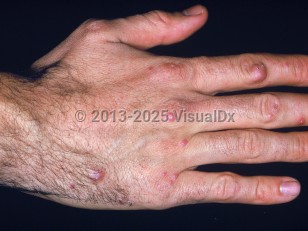Sea urchin sting
Alerts and Notices
Important News & Links
Synopsis

Sea urchins (Echinoderms) are found in all oceans of the world, from the tropics to the polar regions. They have globe-shaped bodies covered with sharp, brittle spines. On the spine tip, a venom gland may be present. Some species also have hook-like jaws (pedicellaria) that can deliver venom. There are 600 species of sea urchins; 80 are venomous.
Bathers, surfers, divers, and fishermen are at risk for injuries caused by contact with sea urchins. When accidentally stepped upon, picked up, or brushed up against, spines can puncture the skin, causing severe burning and pain that is typically out of proportion to the injury. The pain often lasts for several hours and then becomes a dull ache that can radiate centrally. The area around the spine may swell, become inflamed, and feel numb. Black discoloration due to ink from the spines at puncture sites may be seen and last for days. Uncomplicated wounds heal within a week or two.
Complications include retained spines, secondary infection, ulceration, and delayed hypersensitivity.
Envenomation by some species can cause severe systemic symptoms. Malaise, weakness, shock, and bulbar or respiratory paralysis have been reported.
Bathers, surfers, divers, and fishermen are at risk for injuries caused by contact with sea urchins. When accidentally stepped upon, picked up, or brushed up against, spines can puncture the skin, causing severe burning and pain that is typically out of proportion to the injury. The pain often lasts for several hours and then becomes a dull ache that can radiate centrally. The area around the spine may swell, become inflamed, and feel numb. Black discoloration due to ink from the spines at puncture sites may be seen and last for days. Uncomplicated wounds heal within a week or two.
Complications include retained spines, secondary infection, ulceration, and delayed hypersensitivity.
Envenomation by some species can cause severe systemic symptoms. Malaise, weakness, shock, and bulbar or respiratory paralysis have been reported.
Codes
ICD10CM:
T63.691A – Toxic effect of contact with other venomous marine animals, accidental, initial encounter
SNOMEDCT:
217685001 – Puncture by sea urchin spine
T63.691A – Toxic effect of contact with other venomous marine animals, accidental, initial encounter
SNOMEDCT:
217685001 – Puncture by sea urchin spine
Look For
Subscription Required
Diagnostic Pearls
Subscription Required
Differential Diagnosis & Pitfalls

To perform a comparison, select diagnoses from the classic differential
Subscription Required
Best Tests
Subscription Required
Management Pearls
Subscription Required
Therapy
Subscription Required
References
Subscription Required
Last Updated:10/04/2017

